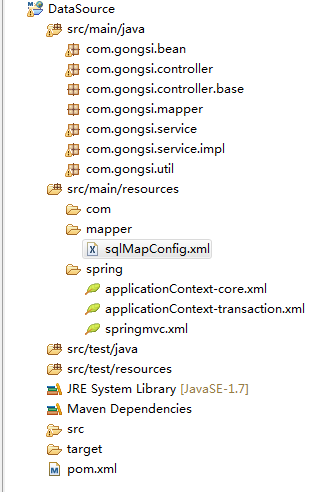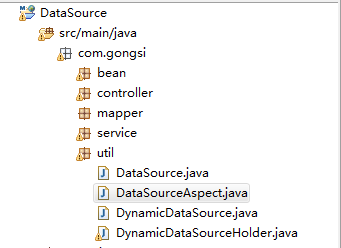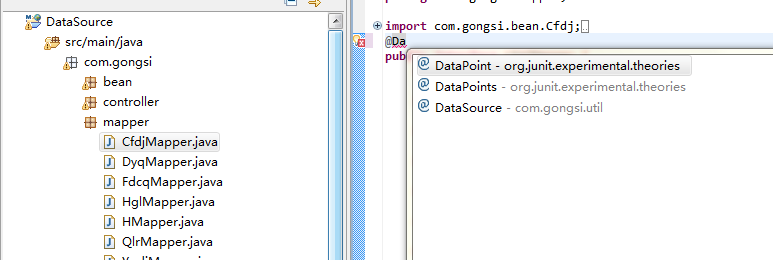ssm框架实现多数据源的配置,本人亲测,项目正在使用。
2017-12-23 16:30
579 查看
1、这是项目的目录结构

2、Web.XML
<?xml version="1.0" encoding="UTF-8"?>
<web-app xmlns:xsi="http://www.w3.org/2001/XMLSchema-instance" xmlns="http://java.sun.com/xml/ns/javaee" xsi:schemaLocation="http://java.sun.com/xml/ns/javaee http://java.sun.com/xml/ns/javaee/web-app_3_0.xsd" id="WebApp_ID" version="3.0">
<!-- 初始化spring容器-->
<context-param>
<param-name>contextConfigLocation</param-name>
<param-value>
classpath*:spring/applicationContext-*.xml,
</param-value>
</context-param>
<listener>
<listener-class>org.springframework.web.context.ContextLoaderListener</listener-class>
</listener>
<servlet>
<servlet-name>springmvc</servlet-name>
<servlet-class>org.springframework.web.servlet.DispatcherServlet</servlet-class>
<!--
扫描Springmvc
-->
<init-param>
<param-name>contextConfigLocation</param-name>
<param-value>classpath:spring/springmvc.xml</param-value>
</init-param>
<load-on-startup>1</load-on-startup>
</servlet>
<!-- 拦截所有 -->
<servlet-mapping>
<servlet-name>springmvc</servlet-name>
<url-pattern>/</url-pattern>
</servlet-mapping>
<!-- post乱码处理-->
<filter>
<filter-name>CharacterEncodingFilter</filter-name>
<filter-class>org.springframework.web.filter.CharacterEncodingFilter</filter-class>
<init-param>
<param-name>encoding</param-name>
<param-value>utf-8</param-value>
</init-param>
</filter>
<filter-mapping>
<filter-name>CharacterEncodingFilter</filter-name>
<url-pattern>/*</url-pattern>
</filter-mapping>
<welcome-file-list>
<welcome-file>index.jsp</welcome-file>
</welcome-file-list>
</web-app>
3、sqlMapConfig.xml
<!DOCTYPE configuration
PUBLIC "-//mybatis.org//DTD Config 3.0//EN"
"http://mybatis.org/dtd/mybatis-3-config.dtd">
<configuration>
<typeAliases>
<!-- 扫描当前包下的所有的类 类型的名称就是类名(首字母大写或小写) -->
<package name="com.gongsi.bean"/>
</typeAliases>
</configuration>
4、applicationContext-core.xml
<?xml version="1.0" encoding="UTF-8"?>
<beans xmlns="http://www.springframework.org/schema/beans"
xmlns:xsi="http://www.w3.org/2001/XMLSchema-instance" xmlns:mvc="http://www.springframework.org/schema/mvc"
xmlns:context="http://www.springframework.org/schema/context"
xmlns:aop="http://www.springframework.org/schema/aop" xmlns:tx="http://www.springframework.org/schema/tx"
xsi:schemaLocation="http://www.springframework.org/schema/beans http://www.springframework.org/schema/beans/spring-beans-3.2.xsd http://www.springframework.org/schema/mvc http://www.springframework.org/schema/mvc/spring-mvc-3.2.xsd http://www.springframework.org/schema/context http://www.springframework.org/schema/context/spring-context-3.2.xsd http://www.springframework.org/schema/aop http://www.springframework.org/schema/aop/spring-aop-3.2.xsd http://www.springframework.org/schema/tx http://www.springframework.org/schema/tx/spring-tx-3.2.xsd ">
<!-- 开启注解模式 -->
<context:annotation-config />
<!-- 扫描我们 action service dao 文件 -->
<context:component-scan base-package="com.gongsi.*"></context:component-scan>
<!-- 物理数据源 -->
<!--我是用的SQLServer数据库,可自行调换 -->
<bean id="MydataSource_1" class="org.apache.commons.dbcp.BasicDataSource" destroy-method="close">
<property name="driverClassName" value="com.microsoft.sqlserver.jdbc.SQLServerDriver"></property>
<property name="url" value="jdbc:sqlserver://localhost:****;DatabaseName=**"></property>
<property name="username" value="**"></property>
<property name="password" value="****"></property>
</bean>
<bean id="MydataSource_2" class="org.apache.commons.dbcp.BasicDataSource" destroy-method="close">
<property name="driverClassName" value="com.microsoft.sqlserver.jdbc.SQLServerDriver"></property>
<property name="url" value="jdbc:sqlserver://localhost:****;DatabaseName=****"></property>
<property name="username" value="**"></property>
<property name="password" value="****"></property>
</bean>
<bean id="dataSource" class="com.gongsi.util.DynamicDataSource">
<property name="targetDataSources">
<map key-type="java.lang.String">
<!-- 指定lookupKey和与之对应的数据源 -->
<entry key="1" value-ref="MydataSource_1"></entry>
<entry key="2" value-ref="MydataSource_2"></entry>
</map>
</property>
<!-- 这里可以指定默认的数据源 -->
<property name="defaultTargetDataSource" ref="MydataSource_2" />
</bean>
<!-- 通过IOC管理sqlSessionFactory -->
<bean id="MysqlSessionFactory" class="org.mybatis.spring.SqlSessionFactoryBean">
<property name="dataSource" ref="dataSource"></property>
<!-- 加载我们的mybatis的总控制文件 -->
<property name="configLocation" value="classpath:mapper/sqlMapConfig.xml"></property>
</bean>
<bean class="org.mybatis.spring.mapper.MapperScannerConfigurer">
<!--
扫描当前包下的所有mapper 如果映射关系文件不再一个包中,我们多个包之间使用逗号分隔
在程序中获取接口代理的名称就是当前接口的首字母小写形式
-->
<property name="basePackage" value="com.gongsi.mapper"></property>
<!-- 使用sqlSessionFactory -->
<property name="sqlSessionFactoryBeanName" value="MysqlSessionFactory"></property>
</bean>
</beans>
5、applicationContext-transaction.xml
<?xml version="1.0" encoding="UTF-8"?>
<beans xmlns="http://www.springframework.org/schema/beans"
xmlns:xsi="http://www.w3.org/2001/XMLSchema-instance" xmlns:mvc="http://www.springframework.org/schema/mvc"
xmlns:context="http://www.springframework.org/schema/context"
xmlns:aop="http://www.springframework.org/schema/aop" xmlns:tx="http://www.springframework.org/schema/tx"
xsi:schemaLocation="http://www.springframework.org/schema/beans http://www.springframework.org/schema/beans/spring-beans-3.2.xsd http://www.springframework.org/schema/mvc http://www.springframework.org/schema/mvc/spring-mvc-3.2.xsd http://www.springframework.org/schema/context http://www.springframework.org/schema/context/spring-context-3.2.xsd http://www.springframework.org/schema/aop http://www.springframework.org/schema/aop/spring-aop-3.2.xsd http://www.springframework.org/schema/tx http://www.springframework.org/schema/tx/spring-tx-3.2.xsd ">
<!-- 声明spring中的事务管理器 -->
<bean id="manager" class="org.springframework.jdbc.datasource.DataSourceTransactionManager">
<property name="dataSource" ref="dataSource"></property>
</bean>
<tx:advice id="Myadvice" transaction-manager="manager">
<tx:attributes>
<!-- REQUIRED 事务的传播性,如果没有事务给当前的方法开启一个新的事务 -->
<tx:method name="save*" propagation="REQUIRED"/>
<tx:method name="delete*" propagation="REQUIRED"/>
<tx:method name="update*" propagation="REQUIRED"/>
<!-- 這個類型的方法不需要使用事務 -->
<tx:method name="find*" propagation="SUPPORTS" read-only="true"/>
</tx:attributes>
</tx:advice>
<aop:aspectj-autoproxy></aop:aspectj-autoproxy>
<bean id="dataSourceAspect" class="com.gongsi.util.DataSourceAspect" />
<aop:config>
<aop:aspect ref="dataSourceAspect" >
<!-- 拦截所有service方法 -->
<!--我这里实在Mapper上面加的注解,可自行调换 -->
<aop:pointcut id="dataSourcePointcut" expression="execution(* com.gongsi.mapper..*.*(..))"/>
<aop:before pointcut-ref="dataSourcePointcut" method="intercept" />
</aop:aspect>
</aop:config>
</beans>
6、springmvc.xml
<?xml version="1.0" encoding="UTF-8"?>
<beans xmlns="http://www.springframework.org/schema/beans"
xmlns:xsi="http://www.w3.org/2001/XMLSchema-instance" xmlns:mvc="http://www.springframework.org/schema/mvc"
xmlns:context="http://www.springframework.org/schema/context"
xmlns:aop="http://www.springframework.org/schema/aop" xmlns:tx="http://www.springframework.org/schema/tx"
xsi:schemaLocation="http://www.springframework.org/schema/beans http://www.springframework.org/schema/beans/spring-beans-3.2.xsd http://www.springframework.org/schema/mvc http://www.springframework.org/schema/mvc/spring-mvc-3.2.xsd http://www.springframework.org/schema/context http://www.springframework.org/schema/context/spring-context-3.2.xsd http://www.springframework.org/schema/aop http://www.springframework.org/schema/aop/spring-aop-3.2.xsd http://www.springframework.org/schema/tx http://www.springframework.org/schema/tx/spring-tx-3.2.xsd ">
<mvc:annotation-driven/>
<!--自动扫描,使springMVC认为包下用了@controller注解的类是控制器-->
<context:component-scan base-package="com.gongsi.controller"></context:component-scan>
<!-- 视图解析器:通用的 -->
<bean class="org.springframework.web.servlet.view.InternalResourceViewResolver">
<property name="prefix" value="/jsp/"></property>
<property name="suffix" value=".jsp"></property>
</bean>
<!-- 映射器 -->
<bean class="org.springframework.web.servlet.mvc.method.annotation.RequestMappingHandlerMapping"></bean>
<!-- 适配器 -->
<bean class="org.springframework.web.servlet.mvc.method.annotation.RequestMappingHandlerAdapter">
<!-- 整合json使用配置 -->
<property name="messageConverters">
<list>
<bean
class="org.springframework.http.converter.json.MappingJacksonHttpMessageConverter"></bean>
</list>
</property>
</bean>
</beans>
7、自定义注解目录

8、DataSource.java
package com.gongsi.util;
import java.lang.annotation.Retention;
import java.lang.annotation.Target;
import java.lang.annotation.RetentionPolicy;
import java.lang.annotation.ElementType;
/*@Retention(RetentionPolicy.RUNTIME)
@Target(ElementType.METHOD)*/
@Target({ElementType.TYPE,ElementType.METHOD})
@Retention(RetentionPolicy.RUNTIME)
public @interface DataSource {
String value();
}
9、DataSourceAspect.java
package com.gongsi.util;
import java.lang.reflect.Method;
import org.aspectj.lang.JoinPoint;
import org.aspectj.lang.reflect.MethodSignature;
public class DataSourceAspect {
/**
* 拦截目标方法,获取由@DataSource指定的数据源标识,设置到线程存储中以便切换数据源
*
* @param point
* @throws Exception
*/
public void intercept(JoinPoint point) throws Exception {
Class<?> target = point.getTarget().getClass();
MethodSignature signature = (MethodSignature) point.getSignature();
// 默认使用目标类型的注解,如果没有则使用其实现接口的注解
for (Class<?> clazz : target.getInterfaces()) {
resolveDataSource(clazz, signature.getMethod());
}
resolveDataSource(target, signature.getMethod());
}
/**
* 提取目标对象方法注解和类型注解中的数据源标识
*
* @param clazz
* @param method
*/
private void resolveDataSource(Class<?> clazz, Method method) {
try {
Class<?>[] types = method.getParameterTypes();
// 默认使用类型注解
if (clazz.isAnnotationPresent(DataSource.class)) {
DataSource source = clazz.getAnnotation(DataSource.class);
DynamicDataSourceHolder.setDataSource(source.value());
}
// 方法注解可以覆盖类型注解
Method m = clazz.getMethod(method.getName(), types);
if (m != null && m.isAnnotationPresent(DataSource.class)) {
DataSource source = m.getAnnotation(DataSource.class);
DynamicDataSourceHolder.setDataSource(source.value());
}
} catch (Exception e) {
System.out.println(clazz + ":" + e.getMessage());
}
}
}
10、DynamicDataSource.java
package com.gongsi.util;
import org.springframework.jdbc.datasource.lookup.AbstractRoutingDataSource;
public class DynamicDataSource extends AbstractRoutingDataSource {
@Override
protected Object determineCurrentLookupKey() {
// 从自定义的位置获取数据源标识
return DynamicDataSourceHolder.getDataSource();
}
}
11、DynamicDataSourceHolder.java
package com.gongsi.util;
import java.lang.annotation.Retention;
import java.lang.annotation.Target;
import java.lang.annotation.RetentionPolicy;
import java.lang.annotation.ElementType;
public class DynamicDataSourceHolder {
/**
* 注意:数据源标识保存在线程变量中,避免多线程操作数据源时互相干扰
*/
private static final ThreadLocal<String> THREAD_DATA_SOURCE = new ThreadLocal<String>();
public static String getDataSource() {
return THREAD_DATA_SOURCE.get();
}
public static void setDataSource(String dataSource) {
THREAD_DATA_SOURCE.set(dataSource);
}
public static void clearDataSource() {
THREAD_DATA_SOURCE.remove();
}
}
12、使用注解

13、注解的具体使用

里面的value值是在这个文件里面定义的,分离数据库的key

14、本人项目正在使用,所以童叟无欺。附下载地址:http://download.csdn.net/download/qq_38063475/10170674
,可加群321964905

2、Web.XML
<?xml version="1.0" encoding="UTF-8"?>
<web-app xmlns:xsi="http://www.w3.org/2001/XMLSchema-instance" xmlns="http://java.sun.com/xml/ns/javaee" xsi:schemaLocation="http://java.sun.com/xml/ns/javaee http://java.sun.com/xml/ns/javaee/web-app_3_0.xsd" id="WebApp_ID" version="3.0">
<!-- 初始化spring容器-->
<context-param>
<param-name>contextConfigLocation</param-name>
<param-value>
classpath*:spring/applicationContext-*.xml,
</param-value>
</context-param>
<listener>
<listener-class>org.springframework.web.context.ContextLoaderListener</listener-class>
</listener>
<servlet>
<servlet-name>springmvc</servlet-name>
<servlet-class>org.springframework.web.servlet.DispatcherServlet</servlet-class>
<!--
扫描Springmvc
-->
<init-param>
<param-name>contextConfigLocation</param-name>
<param-value>classpath:spring/springmvc.xml</param-value>
</init-param>
<load-on-startup>1</load-on-startup>
</servlet>
<!-- 拦截所有 -->
<servlet-mapping>
<servlet-name>springmvc</servlet-name>
<url-pattern>/</url-pattern>
</servlet-mapping>
<!-- post乱码处理-->
<filter>
<filter-name>CharacterEncodingFilter</filter-name>
<filter-class>org.springframework.web.filter.CharacterEncodingFilter</filter-class>
<init-param>
<param-name>encoding</param-name>
<param-value>utf-8</param-value>
</init-param>
</filter>
<filter-mapping>
<filter-name>CharacterEncodingFilter</filter-name>
<url-pattern>/*</url-pattern>
</filter-mapping>
<welcome-file-list>
<welcome-file>index.jsp</welcome-file>
</welcome-file-list>
</web-app>
3、sqlMapConfig.xml
<!DOCTYPE configuration
PUBLIC "-//mybatis.org//DTD Config 3.0//EN"
"http://mybatis.org/dtd/mybatis-3-config.dtd">
<configuration>
<typeAliases>
<!-- 扫描当前包下的所有的类 类型的名称就是类名(首字母大写或小写) -->
<package name="com.gongsi.bean"/>
</typeAliases>
</configuration>
4、applicationContext-core.xml
<?xml version="1.0" encoding="UTF-8"?>
<beans xmlns="http://www.springframework.org/schema/beans"
xmlns:xsi="http://www.w3.org/2001/XMLSchema-instance" xmlns:mvc="http://www.springframework.org/schema/mvc"
xmlns:context="http://www.springframework.org/schema/context"
xmlns:aop="http://www.springframework.org/schema/aop" xmlns:tx="http://www.springframework.org/schema/tx"
xsi:schemaLocation="http://www.springframework.org/schema/beans http://www.springframework.org/schema/beans/spring-beans-3.2.xsd http://www.springframework.org/schema/mvc http://www.springframework.org/schema/mvc/spring-mvc-3.2.xsd http://www.springframework.org/schema/context http://www.springframework.org/schema/context/spring-context-3.2.xsd http://www.springframework.org/schema/aop http://www.springframework.org/schema/aop/spring-aop-3.2.xsd http://www.springframework.org/schema/tx http://www.springframework.org/schema/tx/spring-tx-3.2.xsd ">
<!-- 开启注解模式 -->
<context:annotation-config />
<!-- 扫描我们 action service dao 文件 -->
<context:component-scan base-package="com.gongsi.*"></context:component-scan>
<!-- 物理数据源 -->
<!--我是用的SQLServer数据库,可自行调换 -->
<bean id="MydataSource_1" class="org.apache.commons.dbcp.BasicDataSource" destroy-method="close">
<property name="driverClassName" value="com.microsoft.sqlserver.jdbc.SQLServerDriver"></property>
<property name="url" value="jdbc:sqlserver://localhost:****;DatabaseName=**"></property>
<property name="username" value="**"></property>
<property name="password" value="****"></property>
</bean>
<bean id="MydataSource_2" class="org.apache.commons.dbcp.BasicDataSource" destroy-method="close">
<property name="driverClassName" value="com.microsoft.sqlserver.jdbc.SQLServerDriver"></property>
<property name="url" value="jdbc:sqlserver://localhost:****;DatabaseName=****"></property>
<property name="username" value="**"></property>
<property name="password" value="****"></property>
</bean>
<bean id="dataSource" class="com.gongsi.util.DynamicDataSource">
<property name="targetDataSources">
<map key-type="java.lang.String">
<!-- 指定lookupKey和与之对应的数据源 -->
<entry key="1" value-ref="MydataSource_1"></entry>
<entry key="2" value-ref="MydataSource_2"></entry>
</map>
</property>
<!-- 这里可以指定默认的数据源 -->
<property name="defaultTargetDataSource" ref="MydataSource_2" />
</bean>
<!-- 通过IOC管理sqlSessionFactory -->
<bean id="MysqlSessionFactory" class="org.mybatis.spring.SqlSessionFactoryBean">
<property name="dataSource" ref="dataSource"></property>
<!-- 加载我们的mybatis的总控制文件 -->
<property name="configLocation" value="classpath:mapper/sqlMapConfig.xml"></property>
</bean>
<bean class="org.mybatis.spring.mapper.MapperScannerConfigurer">
<!--
扫描当前包下的所有mapper 如果映射关系文件不再一个包中,我们多个包之间使用逗号分隔
在程序中获取接口代理的名称就是当前接口的首字母小写形式
-->
<property name="basePackage" value="com.gongsi.mapper"></property>
<!-- 使用sqlSessionFactory -->
<property name="sqlSessionFactoryBeanName" value="MysqlSessionFactory"></property>
</bean>
</beans>
5、applicationContext-transaction.xml
<?xml version="1.0" encoding="UTF-8"?>
<beans xmlns="http://www.springframework.org/schema/beans"
xmlns:xsi="http://www.w3.org/2001/XMLSchema-instance" xmlns:mvc="http://www.springframework.org/schema/mvc"
xmlns:context="http://www.springframework.org/schema/context"
xmlns:aop="http://www.springframework.org/schema/aop" xmlns:tx="http://www.springframework.org/schema/tx"
xsi:schemaLocation="http://www.springframework.org/schema/beans http://www.springframework.org/schema/beans/spring-beans-3.2.xsd http://www.springframework.org/schema/mvc http://www.springframework.org/schema/mvc/spring-mvc-3.2.xsd http://www.springframework.org/schema/context http://www.springframework.org/schema/context/spring-context-3.2.xsd http://www.springframework.org/schema/aop http://www.springframework.org/schema/aop/spring-aop-3.2.xsd http://www.springframework.org/schema/tx http://www.springframework.org/schema/tx/spring-tx-3.2.xsd ">
<!-- 声明spring中的事务管理器 -->
<bean id="manager" class="org.springframework.jdbc.datasource.DataSourceTransactionManager">
<property name="dataSource" ref="dataSource"></property>
</bean>
<tx:advice id="Myadvice" transaction-manager="manager">
<tx:attributes>
<!-- REQUIRED 事务的传播性,如果没有事务给当前的方法开启一个新的事务 -->
<tx:method name="save*" propagation="REQUIRED"/>
<tx:method name="delete*" propagation="REQUIRED"/>
<tx:method name="update*" propagation="REQUIRED"/>
<!-- 這個類型的方法不需要使用事務 -->
<tx:method name="find*" propagation="SUPPORTS" read-only="true"/>
</tx:attributes>
</tx:advice>
<aop:aspectj-autoproxy></aop:aspectj-autoproxy>
<bean id="dataSourceAspect" class="com.gongsi.util.DataSourceAspect" />
<aop:config>
<aop:aspect ref="dataSourceAspect" >
<!-- 拦截所有service方法 -->
<!--我这里实在Mapper上面加的注解,可自行调换 -->
<aop:pointcut id="dataSourcePointcut" expression="execution(* com.gongsi.mapper..*.*(..))"/>
<aop:before pointcut-ref="dataSourcePointcut" method="intercept" />
</aop:aspect>
</aop:config>
</beans>
6、springmvc.xml
<?xml version="1.0" encoding="UTF-8"?>
<beans xmlns="http://www.springframework.org/schema/beans"
xmlns:xsi="http://www.w3.org/2001/XMLSchema-instance" xmlns:mvc="http://www.springframework.org/schema/mvc"
xmlns:context="http://www.springframework.org/schema/context"
xmlns:aop="http://www.springframework.org/schema/aop" xmlns:tx="http://www.springframework.org/schema/tx"
xsi:schemaLocation="http://www.springframework.org/schema/beans http://www.springframework.org/schema/beans/spring-beans-3.2.xsd http://www.springframework.org/schema/mvc http://www.springframework.org/schema/mvc/spring-mvc-3.2.xsd http://www.springframework.org/schema/context http://www.springframework.org/schema/context/spring-context-3.2.xsd http://www.springframework.org/schema/aop http://www.springframework.org/schema/aop/spring-aop-3.2.xsd http://www.springframework.org/schema/tx http://www.springframework.org/schema/tx/spring-tx-3.2.xsd ">
<mvc:annotation-driven/>
<!--自动扫描,使springMVC认为包下用了@controller注解的类是控制器-->
<context:component-scan base-package="com.gongsi.controller"></context:component-scan>
<!-- 视图解析器:通用的 -->
<bean class="org.springframework.web.servlet.view.InternalResourceViewResolver">
<property name="prefix" value="/jsp/"></property>
<property name="suffix" value=".jsp"></property>
</bean>
<!-- 映射器 -->
<bean class="org.springframework.web.servlet.mvc.method.annotation.RequestMappingHandlerMapping"></bean>
<!-- 适配器 -->
<bean class="org.springframework.web.servlet.mvc.method.annotation.RequestMappingHandlerAdapter">
<!-- 整合json使用配置 -->
<property name="messageConverters">
<list>
<bean
class="org.springframework.http.converter.json.MappingJacksonHttpMessageConverter"></bean>
</list>
</property>
</bean>
</beans>
7、自定义注解目录

8、DataSource.java
package com.gongsi.util;
import java.lang.annotation.Retention;
import java.lang.annotation.Target;
import java.lang.annotation.RetentionPolicy;
import java.lang.annotation.ElementType;
/*@Retention(RetentionPolicy.RUNTIME)
@Target(ElementType.METHOD)*/
@Target({ElementType.TYPE,ElementType.METHOD})
@Retention(RetentionPolicy.RUNTIME)
public @interface DataSource {
String value();
}
9、DataSourceAspect.java
package com.gongsi.util;
import java.lang.reflect.Method;
import org.aspectj.lang.JoinPoint;
import org.aspectj.lang.reflect.MethodSignature;
public class DataSourceAspect {
/**
* 拦截目标方法,获取由@DataSource指定的数据源标识,设置到线程存储中以便切换数据源
*
* @param point
* @throws Exception
*/
public void intercept(JoinPoint point) throws Exception {
Class<?> target = point.getTarget().getClass();
MethodSignature signature = (MethodSignature) point.getSignature();
// 默认使用目标类型的注解,如果没有则使用其实现接口的注解
for (Class<?> clazz : target.getInterfaces()) {
resolveDataSource(clazz, signature.getMethod());
}
resolveDataSource(target, signature.getMethod());
}
/**
* 提取目标对象方法注解和类型注解中的数据源标识
*
* @param clazz
* @param method
*/
private void resolveDataSource(Class<?> clazz, Method method) {
try {
Class<?>[] types = method.getParameterTypes();
// 默认使用类型注解
if (clazz.isAnnotationPresent(DataSource.class)) {
DataSource source = clazz.getAnnotation(DataSource.class);
DynamicDataSourceHolder.setDataSource(source.value());
}
// 方法注解可以覆盖类型注解
Method m = clazz.getMethod(method.getName(), types);
if (m != null && m.isAnnotationPresent(DataSource.class)) {
DataSource source = m.getAnnotation(DataSource.class);
DynamicDataSourceHolder.setDataSource(source.value());
}
} catch (Exception e) {
System.out.println(clazz + ":" + e.getMessage());
}
}
}
10、DynamicDataSource.java
package com.gongsi.util;
import org.springframework.jdbc.datasource.lookup.AbstractRoutingDataSource;
public class DynamicDataSource extends AbstractRoutingDataSource {
@Override
protected Object determineCurrentLookupKey() {
// 从自定义的位置获取数据源标识
return DynamicDataSourceHolder.getDataSource();
}
}
11、DynamicDataSourceHolder.java
package com.gongsi.util;
import java.lang.annotation.Retention;
import java.lang.annotation.Target;
import java.lang.annotation.RetentionPolicy;
import java.lang.annotation.ElementType;
public class DynamicDataSourceHolder {
/**
* 注意:数据源标识保存在线程变量中,避免多线程操作数据源时互相干扰
*/
private static final ThreadLocal<String> THREAD_DATA_SOURCE = new ThreadLocal<String>();
public static String getDataSource() {
return THREAD_DATA_SOURCE.get();
}
public static void setDataSource(String dataSource) {
THREAD_DATA_SOURCE.set(dataSource);
}
public static void clearDataSource() {
THREAD_DATA_SOURCE.remove();
}
}
12、使用注解

13、注解的具体使用

里面的value值是在这个文件里面定义的,分离数据库的key

14、本人项目正在使用,所以童叟无欺。附下载地址:http://download.csdn.net/download/qq_38063475/10170674
,可加群321964905
相关文章推荐
- 使用SSM框架搭建web项目配置步骤
- 使用ssm框架进行整合,实现一个小的项目,对员工信息的增删改查
- ssm框架使用详解&配置两个数据源
- J2EE项目系列(四)--SSM框架构建积分系统和基本商品检索系统(Spring+SpringMVC+MyBatis)(3)Ajax使用详解(级联列表)以及企业级报表Excel导入导出实现
- 在Java Web项目里实现IOC(不使用框架,自己通过代码实现)
- 多数据源的动态配置与加载使用兼框架交互的问题调试
- SSH三大框架整合使用的配置文件 注解实现
- web项目取得spring配置的数据源的简单实现方法
- 配合.NET MVC 写自己的框架,实现动态配置页面数据源及方便可扩展性
- 本人在一个项目开发中所使用的框架和技术
- 使用Log4j为项目配置日志输出应用详解以及示例演示的实现分析
- android 项目中使用到的网络请求框架以及如何配置好接口URL
- 菜鸟使用SSM框架搭建web服务器实现登录功能(Spring+SpringMVC+Mybatis)
- 项目重构之数据源配置与优化:log4j 配置数据库连接池Druid,并实现日志存储到数据库
- 使用注解,实现ssh项目中spring配置文件的零配置,约定优于配置
- CentOS下使用SVN实现多项目管理配置方案
- [开源项目-MyBean轻量级配置框架] 使用MyBean快速搭建分模块的应用程序(主页面的TAB)(DLL-MDI)
- (转)从零实现3D图像引擎:(1)环境配置与项目框架
- 项目重构之数据源配置与优化:log4j 配置数据库连接池Druid,并实现日志存储到数据库
